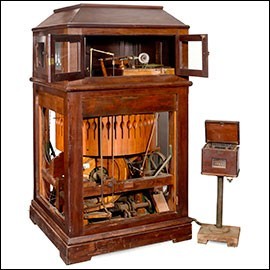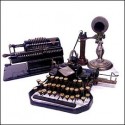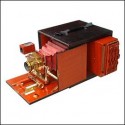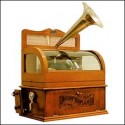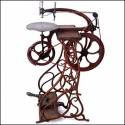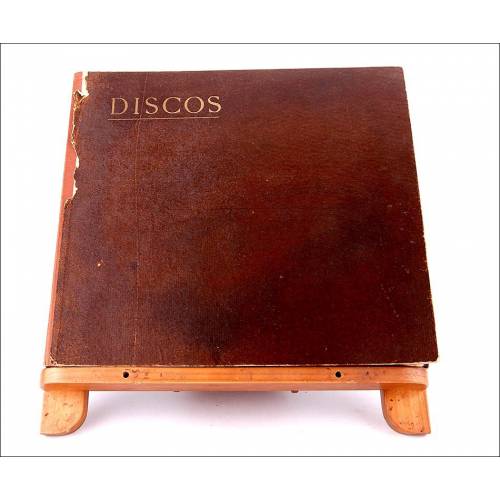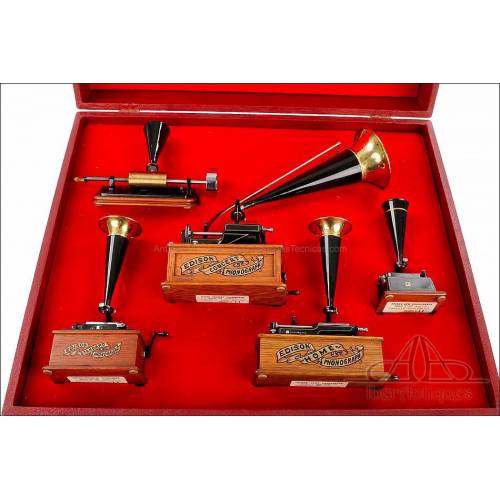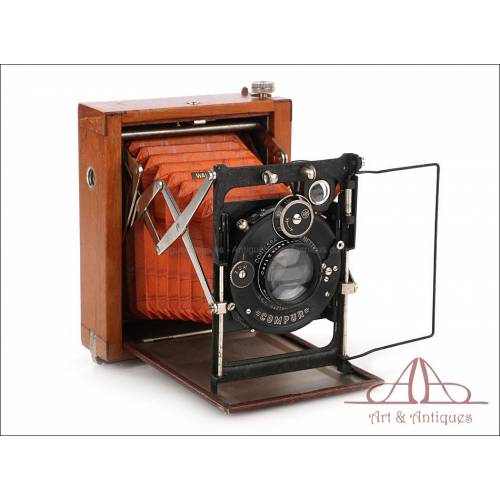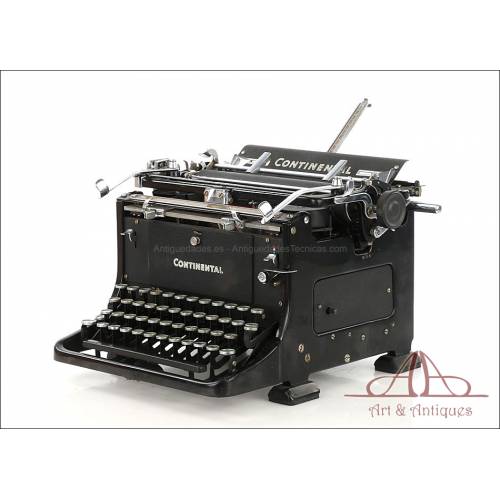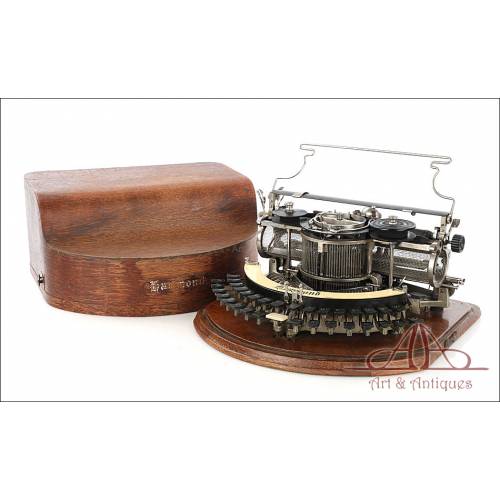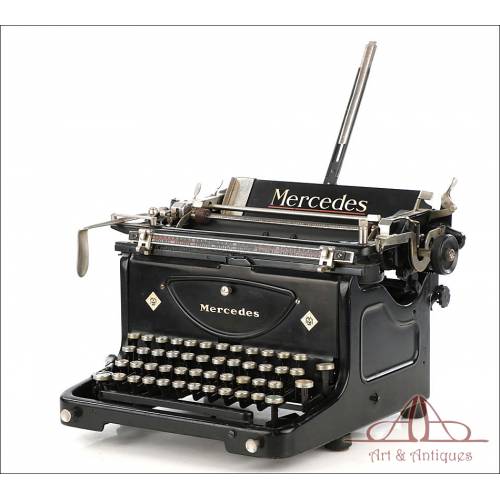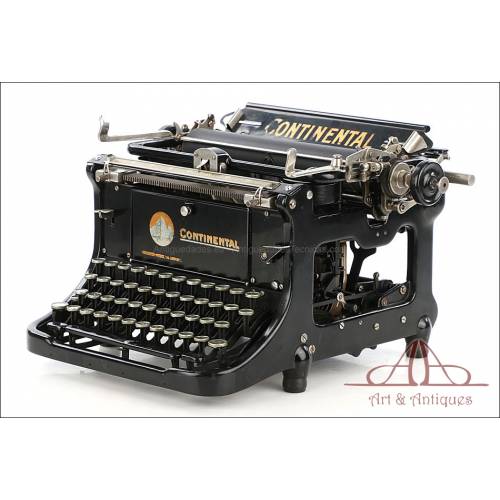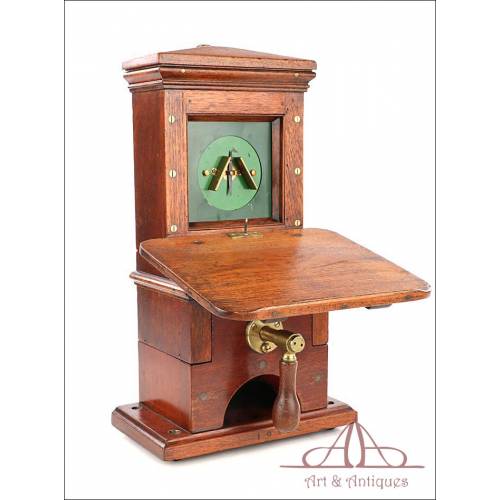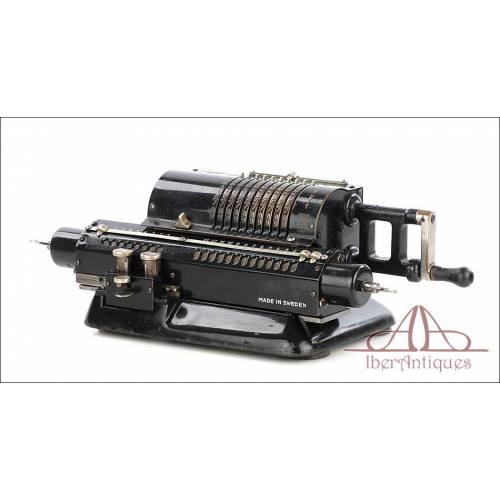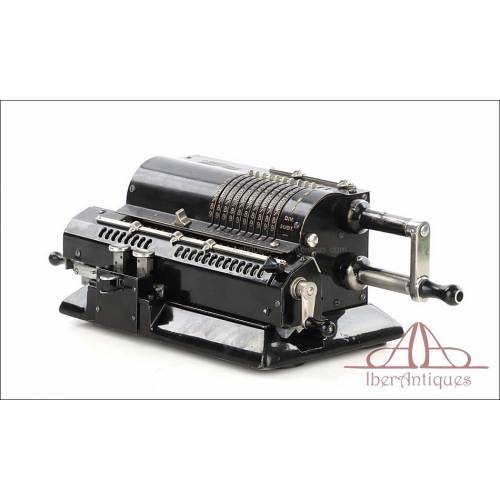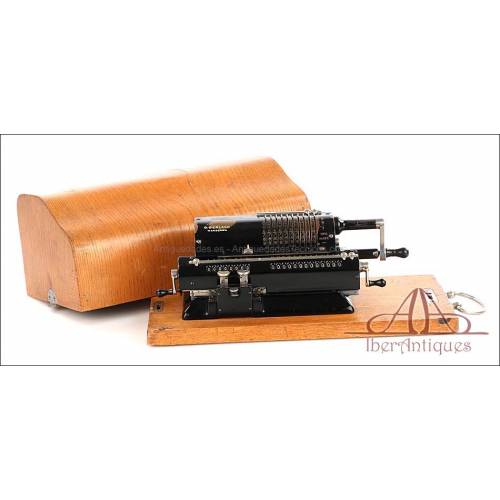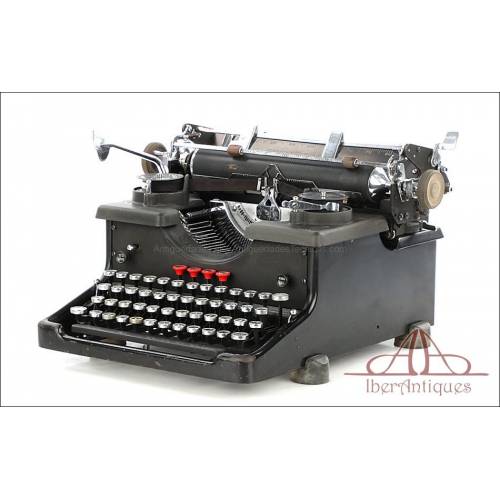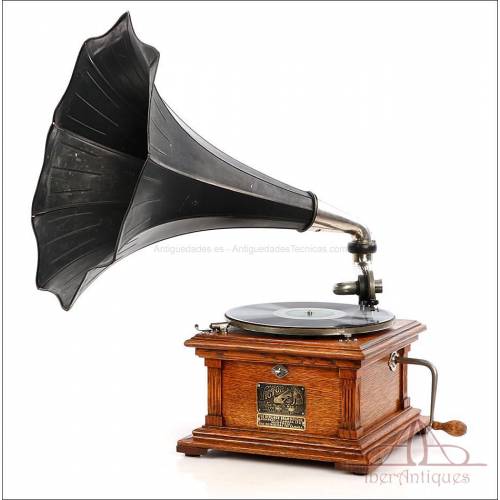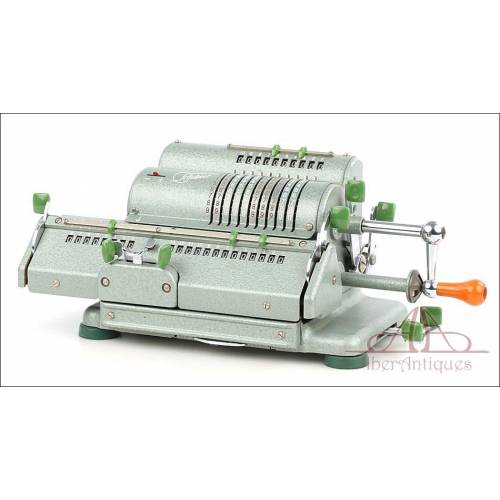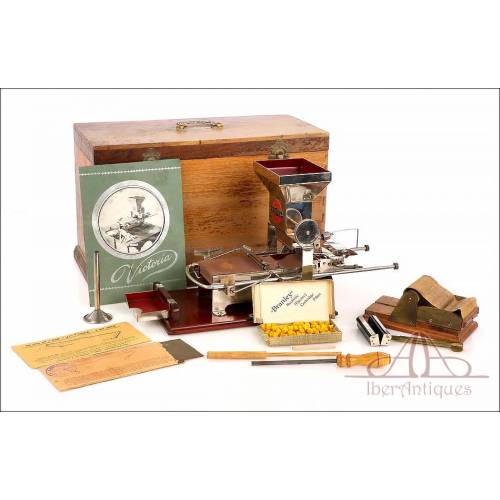Technical Antiques
Machines have accompanied man since ancient times. In fact, they arise from the need to find solutions to common problems of their daily lives. This is the reason why the wheel is considered to be the first to be invented. From there, thanks to the usefulness that our ancestors found in it to move things more easily, they began to develop supple...
Machines have accompanied man since ancient times. In fact, they arise from the need to find solutions to common problems of their daily lives. This is the reason why the wheel is considered to be the first to be invented. From there, thanks to the usefulness that our ancestors found in it to move things more easily, they began to develop supplementary instruments such as levers, grain grinders, carts, lathes..... The machines of that time worked from the strength of the user's or animals' muscles.
From this point a great leap is made to the time when man begins to manipulate copper, iron, lead and other metals. Hundreds and hundreds of years later, as early as the 15th century, Leonardo Da Vinci's machine designs were a milestone. James Watt's steam engine, Frederick Winslow's direct current motor and Vladimir Zworkin's cathode ray tube televisions were other great machines that have made the world as we know it possible and are now highly valued technical antiques.
They are also great machines that have made the world as we know it possible.
Why collect technical antiques?
Technical antiques have something special that attracts the attention of anyone. And it is that, when we take a look at them, they bring to mind the ways of life of our ancestors and allow us to understand it better. It is also undeniable that, aesthetically, in most cases they are very beautiful. In fact, displayed in a home, they are capable of adding a retro touch to any environment. In short, whether you are a collector, you are thinking of becoming one, or you are simply looking to give a gift to someone special or treat yourself, enter this fascinating section. You will be amazed with our technical antiques.
What antiques are you looking for?
What technical antiques can you find here?
These are the technical antiques, divided by sections, that you can find here:
- - Office antiques. As the name suggests, these are machines used in the professional environment of companies. In it is possible to find from really old calculators to typewriters and telephones with more than 100 years old.
- - Antique cameras. Cameras, as well as film and slide projectors, are some of the antiques that attract the most attention from collectors. For this reason, this section is one of the most visited. In addition, it is also possible to find magic lanterns.
- - Antique musical instruments. Other antiques in high demand. Here you will see a wide variety of music boxes, phonographs, gramophones, record players, vinyl records and needles.
- - Other mechanical antiques. In it you will be able to find any other machine that cannot be encompassed in any of the previously mentioned sections.
Subcategories
Office Antiques
The long history of office work
Office work has a long history. Along with it have been appearing a lot of utensils and work tools to make more effective and bearable the work in any office or administrative space. These office tools have become true jewels over time, given their refined design and sophisticated mechanism. Office work, with its primordial starting point in the invention of the printing press, has been fundamental for the progress of cities, and all the tools that populated the office worker's desk have been witnesses to this.
Office antiques: true collector's gems
Over time, antique office tools and supplies have become true collector's gems. The enormous beauty they possess, coupled with their perfect functionality, have placed them as objects highly appreciated by art and aesthetic beauty lovers. They are highly valued pieces, which can be displayed in your office for the simple pleasure of contemplation, and at the same time can be used to solve the operations and functions required for office work. In any case, owning a collection of antique office items is an unmistakable symptom of good taste.
Pieces that can be found in this section
Among the large number of office antiques offered on the market, below we will expose the most sought after by collectors, given their external aesthetic value and their internal design and functionality. They are as follows:
-Antique typewriters. Without any doubt, antique typewriters are the true crown jewel in any collection of office tools. Machines are preserved in an impeccable condition, perfectly arranged for use. They are of the most legendary brands (Olivetti, Underwood, Remington...) and of a long tradition: from 1880 to the 1950s.-Antique calculators. Watching the operation of an antique calculating machine is a real treat for the senses. The mechanism with which they are designed is exhibited in a very sophisticated and majestic way. They are true works of art of engineering and hence their high value for collectors. The best brands on the market are offered, from the year 1850 to 1970: Triumphator, Lipsia, Brunsviga, Thales...They are available in a very sophisticated and majestic way.
-Antique telephones. Telephony has improved a lot over time, but the old telephones have left us a real mark for their technological capacity and their beauty. Lovers of this type of antiques will be able to add to their collection wall phones, table phones, wooden phones, Bakelite phones, candle phones, gondola phones, etc. All of these antiques are available in a variety of styles.
-Antique telegraphs. Long before the invention of the telephone and other more modern communication systems, the telegraph, created by Samuel Morse, was in use. Telegraphs are authentic relics, which you can now add to your wonderful collection.The telegraphs are authentic relics, which you can now add to your wonderful collection.
-Other office antiques. Finally, you can complete your fantastic collection of office antiques by collecting other utensils, such as rubber and dry stamps, letter openers, pencil sharpeners, pencil sharpeners, furniture, etc.
Antique cameras
If there is a collector's item that raises passions among antique lovers, it is antique cameras. The art of photography is, in itself, fascinating. Decades ago, capturing images on plates or sheets of paper thanks to the action of light seemed like magic; and today it continues to arouse our admiration. Digital cameras have definitively left behind the charm of the printing process, in which the photographed images gradually emerged on a sheet of paper impregnated with emulsion. However, there are still many people who love antique cameras, collect them and use them to take snapshots. They are very special images, with an intense power of attraction that no digital photography has ever been able to match.
History of antique cameras
The history of cameras has a much older origin than photography itself. To trace its beginnings we must go back to the fourth century BC, when the Chinese philosopher Mozi laid the foundations for the operation of the camera obscura. Over the centuries more scientists became interested in optics and image reflection; in the 11th century, the Arab physicist Ibn al-Haytham wrote important treatises reflecting experiments in a dark room, into which light entered through a small hole. However, it was not until 1816 that the first photographic camera in history was built. Its creator was Nicéphore Niepce, who managed to make some snapshots on paper impregnated with silver chloride, one of which (View from the window at Le Gras, 1826-27) has survived to the present day.
Throughout the 20th century, the evolution of vintage cameras to the designs we know today has been truly dizzying. Milestones such as the appearance of the first camera with built-in film (designed by George Eastman in 1885), Polaroid's instant photographs (introduced in 1947) or the launch of digital cameras (the first model was designed by engineer Steven J. Sasson in 1975 for Kodak, although it was not intended for commercialization) are key in the history of photographic cameras. Today, the final evolution has reached cell phone cameras, which are capable of delivering extremely high quality images with the ability to perform on-the-spot editing.
Types of antique cameras
Antique photo cameras, meaning those manufactured and marketed before the 1960s, come in different formats and types. The most important ones are:
Antique plate cameras
They were the first to appear on the market. Initially, the only people who had access to them were photographers, as they were a necessary investment for the practice of their profession. People went to the studio to have their portraits taken at important moments in their lives: baptisms, weddings, deaths... They were usually bellows or folding cameras, bulky pieces that were placed on a tripod. These cameras were used until the 1930s, when they were definitively displaced by film models.
Antique cameras with film.
As we have discussed, the first roll film camera was designed by George Eastman in 1885 and marketed by his company, Kodak. With logical improvements developed over the decades, these cameras maintained their design throughout the 20th century, until the advent of digital technology. A good example of their magnificent performance are the Leica antique cameras, true icons of photojournalism that still have legions of fans today, and that many photographers continue to use. Within the antique cameras with film, the Leica firm developed the first model for 35 mm film in 1925, which would become the most common format.
Within the world of vintage photography, in addition to cameras we can also find other antique photographic devices that arouse the interest of amateurs and professionals. Lenses, viewfinders, tripods and camera accessories, along with projectors and antique viewfinders for stereoscopic photography, make up a universe of exclusive items that today still retain all their power of fascination.
Antique Musical Devices
Imagine what the world would be like without music. Terrible, no doubt. And yet, not so long ago it was impossible for most people to listen to music at will, whenever they felt like it or needed it. Until the advent of inventions like the radio or the phonograph, there was no way to listen to music unless it was played live. Folk songs were transmitted orally, from fathers and mothers to sons and daughters; music was heard at village festivals, or perhaps in church... On the other hand, "cultured" music was reserved for the upper classes, who could afford to hire chamber orchestras or attend operatic or musical performances.
It was a world without radio or television; without record players, cassettes or CD players. And of course, without Spotify, iTunes, YouTube or streaming music. Something incredible. And yet, the passion that we human beings feel for music managed that the compositions remained in time and continued to be listened to. It could be in the royal parlor or during the Midnight Mass; at the Paris Opera, or in the bandstand of a small village in La Mancha... In the families there was always someone who knew how to play an instrument, or who was even part of the village band. Thus, music managed to reach all corners and was considered a real luxury, a real pleasure.
The first devices that managed to bring the "mechanical" music to all corners were the old music boxes. The first recorded ones date back to the 16th century and were made by Swiss watchmakers. The first models consisted of metal discs, which were replaced by cylinders at the beginning of the 18th century. The evolution of music boxes gave rise to mechanical pianos, pianolas and barrel organs. These devices were commonly used in taverns, parties and popular gatherings, as substitutes for bands and orchestras.
The appearance of musical devices (the famous "talking machines") in the late nineteenth century marked a before and after. Thanks to Edison's phonograph, first; and Marconi's radio, a little later, homes were filled with the wonderful sounds that make up a melody. Phonographs and gramophones made it possible to listen to favorite pieces over and over again, while the radio brought the latest musical news into homes. The evolution of these devices, whose manufacturers advertised with slogans like "Put an orchestra in your house" was dizzying: simpler, better-sounding and more affordable designs were emerging all the time.
The 60s and 70s saw the appearance of new design turntables (those nostalgic pick-ups...),made of plastic, methacrylate, wood, aluminium... Wonderful musical devices that today awaken our fascination, and that collectors seek at auctions, online stores and second-hand flea markets. In the form of portable models or complete furniture, they served to bring the liveliest music to the nightclubs of the time.
Years later and already in the XXI century, turntables again arouse interest and major brands launch models that reproduce the unique sound of the needle on vinyl. But reality rules, and today computer applications are triumphant: music reaches every corner of the planet. However, the beauty of the trumpet gramophones of the beginning of the century, of the tube radios and of the turntables of decades ago is still intact. They bear witness to a revolutionary era that brought music into our lives, and this makes them worthy of our heartfelt tribute.
Other Mechanical Antiques
Mechanical antiques are highly sought after and valued for their beautiful aesthetics and ingenious mechanisms. In addition to classic pieces including typewriters, calculators or clocks, there are other antique mechanically operated devices that stand out in the best collections or as part of the decor. The machines in kitchens of all times are a good example: in the days when there was no electricity, many tasks (such as washing clothes or grinding and chopping food) had to be done by hand. To lighten the work, ingenious gadgets were invented to make them quicker and easier.
And what to say about the wonderful old sewing machines... Its mechanism allowed to sew garments of resistant form and with very regular stitches, to the point that at the present time there are many experts who think that these machines sew better than the modern electronic models. These mechanical antiques are joined by other curious devices such as cigarette rolling machines, mechanical washing machines or mincers and sausage fillers. All of them are fantastic period pieces worthy of admiration, both for the ingenuity shown by their inventors and for their wonderful antique aesthetics.
Sewing machines. They are the most popular mechanical antiques, along with typewriters and calculators. Many people remember watching their mothers, grandmothers or aunts sewing with a Singer, Alpha or Sigma machine, while operating a treadle that spun the wheel at full speed. In fact, some people continue to use them because of the quality of their seams. The first to appear on the market were the German Singer machines (around 1912), which stood out for their smooth operation and beauty. In Spain, the Sigma brand was a sales success as it had nothing to envy to its foreign competitors in terms of beauty or quality of workmanship.
Cigarette rolling machines. . These old-fashioned, mechanically operated machines were a real "hit" after their appearance in 1920. Their ingenious mechanism allowed cigarettes to be rolled quickly, cleanly and easily. In Spain, the most popular was undoubtedly the Victoria model, launched in the 1920s by the Victorero brothers' company. It had a water tank to wet the adhesive side of the paper, a hopper for the tobacco, a crank and a conveyor belt. Today, vintage cigarette rolling machines are highly prized pieces, especially if they are complete and in working order.
Coffee grinders. For decades, in Spanish kitchens there was only one method for grinding coffee beans: doing so in the classic manual grinders, consisting of a wooden box with a hand-crank mechanism. The coffee beans were placed in the upper metallic deposit; when the crank was cranked, the blades ground the beans and the coffee powder was deposited in the lower drawer. In the 1960s, electric grinders replaced these nostalgic devices. Today they are pieces with charm and character, perfect for decorating rustic-style kitchens.
Bread slicing machines. These machines are quite rare pieces. Many of those preserved today are of Italian provenance and consist of a support for the loaf of bread (formed by two boards joined at right angles and placed in V) and a blade with a crank. Its operation is simple: just turn the crank and push the loaf of bread to cut the slices.
Picers and stuffers. These are also classic machines of old kitchens, especially mincers. They are cast iron grinders that were fixed to the tables by means of a vice. Their function was to mince meat, especially for the production of sausages. Sausage stuffers, on the other hand, have a hopper for placing the minced meat and a cylindrical mechanism used to press it into the casing, thus making the sausage.
Old washing machines . Washing machines were another ingenuity designed to make household chores more bearable. The best-known models consisted of a barrel-shaped drum with blades inside, which were turned by a large wheel and pulley mechanism. Clothes were put into the drum along with water and soap. Some washing machines included a drying system consisting of two parallel cylinders with a crank, similar to those used in pasta machines. The first electric washing machines appeared in Europe in 1915, but they would not become popular until the 1960s.The world of mechanical antiques is as fascinating as it is attractive. Collecting such pieces can become a real passion, perfect for lovers of ingenious gadgets with personality.
Album with 12 gramophone records Album with 12 gramophone records
Highlights Bohemios by Vives, Wagner, Scheherazade by Rimsky Korsakow, Russian Choirs. Highlights Bohemios by Vives, Wagner,...
110,00 € 150,00 €Display Set of Edison Phonographs by Manuel Olivé Sans, 1977 Display Set of Edison...
Exclusive collection of 1:4 scale Edison phonographs, crafted by Manuel Olivé Sans in 1977. Limited edition, piece number 14 of 200, with original certificate and case. Exclusive collection of 1:4 scale...
SoldRare Antique Contessa-Nettel Tropical Plate Photo Camera. Germany, Circa 1920 Rare Antique Contessa-Nettel...
Exclusive Contessa-Nettel Tropical Plate photo camera. In amazing condition. Collectors piece. Exclusive Contessa-Nettel Tropical...
750,00 €Antique Continental Typewriter. Working. Germany, Circa 1930 Antique Continental Typewriter....
Astonishing German Continental typewriter in excellent condition. It works and types really fine. Astonishing German Continental...
SoldAntique Hammond 12 Typewriter with Curved Keyboard. USA, 1905 Antique Hammond 12 Typewriter...
Rare and magnificent Hammond 12 typewriter. In excellent condition and working order. Rare and magnificent Hammond 12...
SoldAntique Mercedes Typewriter. Working. Germany, Circa 1930 Antique Mercedes Typewriter....
Beautiful Mercedes typewriter in excellent working order. German keyboard. Beautiful Mercedes typewriter in...
SoldAntique Continental Typewriter. Germany, Circa 1930 Antique Continental Typewriter....
Beautiful Continental typewriter with German keyboard and special keys. In very good condition and fine working order. Beautiful Continental typewriter with...
SoldAntique Needle Telegraph for Railway Environments. England, Circa 1900 Antique Needle Telegraph for...
Authentic needle telegraph for railway environment in amazing condition. With all its original component parts. Museum piece. Authentic needle telegraph for...
SoldAntique Mechanical Original Odhner Calculator, Model 6. Sweden, 1920s Antique Mechanical Original...
Gorgeous Original Odhner 6 calculator from the early 20th century. In excellent working order. Gorgeous Original Odhner 6 calculator...
SoldAntique Original Odhner Mechanical Calculator, Model 27. Sweden, 1930s-40s Antique Original Odhner...
Superb Original Odhner calculator model 27 in amazing working order. In very good condition. Superb Original Odhner calculator...
SoldAntique Original Odhner Mechanical Calculator, Model 27. Case and Key. Sweden, 1930s-40s Antique Original Odhner...
Complete Original Odhner 27 calculator with case. In striking working order. Beautiful piece. Complete Original Odhner 27...
SoldAntique Torpedo Typewriter Model 6. Germany, Circa 1925 Antique Torpedo Typewriter Model...
Imposing antique Torpedo 6 typewriter. With German keyboard and in good working order. Imposing antique Torpedo 6...
SoldAntique Victor II Type M Gramophone-Phonograph. USA, 1907 Antique Victor II Type M...
Awesome Victor II type M phonograph-gramophone, entirely original. It works and sounds great. Spectacular piece. Awesome Victor II type M...
SoldAntique Schubert Mechanical Calculator Mod. DRV. Germany, 1960s Antique Schubert Mechanical...
Nostalgic Schubert DRV pinwheel calculator in striking condition. It is like new and works really fine. Collectors piece. Nostalgic Schubert DRV pinwheel...
SoldAntique Victoria Cigarette Rolling Machine, Spain c.1920 Antique Victoria Cigarette...
Automatic "Victoria" cigarette rolling machine, made in Spain around 1920. Includes original box and all accessories in excellent condition. Ideal for tobacco item collectors. Automatic "Victoria" cigarette...
Sold
New products
-

Antique ivory and silver plated stethoscope, late 19th century
Antique stethoscope from the late 19th century in silver-plated metal...
-

Vintage pendant with shell cameo of Jesús del Gran Poder, carved c. 1970
Vintage pendant with a shell-carved cameo of Jesus del Gran Poder, circa...
-

Antique Roman Style Gilded Silver Chalice with Paten. France, 1932
Antique Roman-style chalice in gilded silver with paten. France, 1932....
-

Beautiful Antique 18 K Gold Ring with 7 Natural Diamonds
Antique 18K gold ring with 7 natural diamonds. Delicate openwork design,...
-

Antique Silver Reliquary. José Vilaplana. Valencia, Spain. Circa 1920
Impressive repoussé silver reliquary by José Vilaplana, Valencia, c....
-

Vintage 18K Gold Ring with 7 Natural Diamonds
Vintage 18K gold ring with seven natural diamonds in floral setting....
-

Antique Silver Chalice. Enameled Crosses. Valencia, Spain, 1942
Spanish chalice from 1942 in solid silver, gifted by the Church of...
-

Antique Silver Chalice and Paten. Granada Spain, circa 1900
Spanish chalice in white silver with matching paten, handcrafted....
Specials
-

Spain, Order of Dert-Ilerca. Decoration formed by Collar Cross and Miniature. 1960's.
Precious decoration, Dert-Ilerca...

